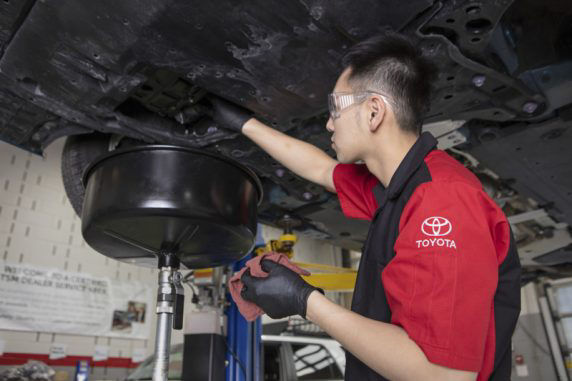Select a province & language
Entrance to this website assumes you have read and agree to these Legal Terms and Conditions and the Privacy Policy.
Entrance to this website assumes you have read and agree to these Legal Terms and Conditions and the Privacy Policy.
Winter is hard on your Toyota and all of its 12,000 parts. It’s one of the reasons why Toyota recommends getting your vehicle serviced every 8,000 km or 6 months, whichever comes first. In this article, we’ll talk about what a Canadian winter does to vehicles and all the things your technicians check and maintain during a Toyota service appointment to minimize winter damage and make sure you’re driving with confidence this spring and summer.

Canadians are nice; Canadian winters are not. Especially to your Toyota. The extreme temperature changes, salt, and other factors add up to a full-out assault on any rubber parts on your Toyota, including tires, wiper blades, door seals, washers, and hoses. That’s why we check and rotate your tires as well as inspect your wipers, the linkage, and washers. Plus, any hoses related to your brakes and other fluids.
Those extreme temperatures, combined with all that moisture and salt, are also very tough on any electronics in your vehicle. Which is to say, almost every part of your vehicle. And as we all know, electronics work perfectly... until they don’t. It’s way better to find out about a faulty connection in the service bay than on a remote highway. During a service our technicians look over a range of systems in your car to check for corrosion or improper connections. This includes checking all of your lights and indicators and doing a full diagnostic on your vehicle’s systems.
All that salt also gets into and corrodes metal parts, linkages, connectors - basically, anything made of metal gets a beating from salt over the winter. So we go over your vehicle in great detail and make sure to take off your tires and visually inspect your brake pads, calipers, rotors, brake lines, and hoses.
We also check all of the fluids that help make your Toyota run smoothly and replace the ones that need it. Engine oil, brake fluid, engine or inverter coolant, power steering fluid, and washer fluid. In fact, changing your oil regularly may be the single best way to extend your Toyota engine’s life. As engine oil breaks down, it starts to chemically degrade. The longer you leave it, the worse it gets, and, if left too long, old oil can actually start to damage your engine. So even if you stop reading here, you already have all the reasons you need to Make A Date Every 8,000 km (or 6 months, whichever comes first).

You’ll find several articles on this site that detail all the reasons to switch your winter tires to all-season tires in the spring. Suffice it to say, we strongly recommend it. But it’s not enough to just put those winter tires away and forget about them until fall. Our technicians check your winter tires when they take them off and inspect your all-season tires when they install them. Tread depth check, sidewall check, pliable tests - your tires are an integral part of a safe drive, so we make sure any tires that go on your Toyota are checked and expertly installed.
It’s a system that no one even realizes has parts: your vehicle’s ventilation and airflow system. It’s an integral part of your vehicle’s performance; but, it’s also a system we use all the time in the cabin. Pretty much the first thing we do once the car is started is turn on the heater, and then we leave it on the whole time we’re driving. That adds up to a lot of air passing through all of our vehicle’s cabin air filters. So when you come in, we check all those filters and let you know if they need replacing. Another thing we check is your air conditioner. You haven’t used it in months, so it’s important to see if it’s ready for that first heatwave.

Toyota has developed an online Personalized Maintenance Schedule for each and every Canadian. Simply type in your Toyota’s vehicle, year, and how many months or kilometers you have on the vehicle.
You’ll get a comprehensive Toyota maintenance schedule that tells you exactly when to come in for service and for what. From brakes to batteries, air filters to oil filters, and coolants to cleaners, our maintenance schedule will make sure your Toyota is running smoothly.
A service appointment in the spring makes sure that whatever happened in winter, stays in winter. Any cold weather car problems, small damage, wear and tear, any fluids that need topping up-- all those things will get inspected and serviced by our expert technicians. So you can enjoy spring and summer on the road, and explore Canada with confidence.